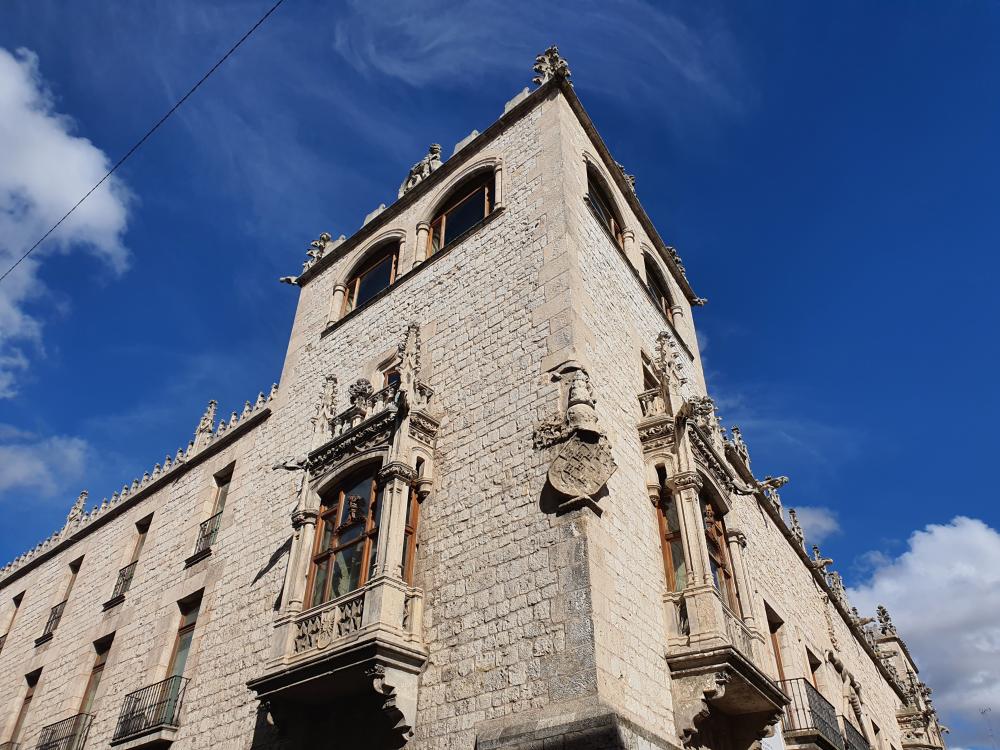1-CASA DEL CORDÓN
The Palace of the Castilian Constables, better known as Casa del Cordón, is a 15th century building located right in the historical centre. It once belonged to Constable Pedro Fernández de Velasco and his wife Mencía de Mendoza. The Gothic-style palace was designed and built by the architect Simón de Colonia. The most remarkable parts are the Franciscan rope of the façade, the side balcony and the large interior courtyard.
2-SAN LORENZO CHURCH
In the old little street of Cantarranas la Menor, the Cantabrian masters, Bernabé de Hazas and Francisco del Portón, built the chapel for the El Salvador Jesuit School in the late 17th century. It was made possible to build thanks to the financial support of Francisco de San Vitores de la Portilla’s will. It is an octagonal-shaped building with a large dome which best represents the Baroque style. In 1767, after the expulsion of the Society of Jesus, the whole building was transformed into the parish of San Lorenzo.
3-CAPITANÍA PALACE
In the place where the four-tower palace was located in the 15th century, nowadays you can find the Capitanía Palace, which was the military command headquarters of Burgos. It now houses the Military Museum. The neoclassical-inspired design was made by the architect Saturnino Martínez. Interestingly, this building hosted the military government headquarters during the Spanish civil war and the last war dispatch was sent from here.
4-SAN GIL CHURCH
This 14th century Gothic temple is commonly known as the ‘’second cathedral’’ due to its size and the magnificent pieces of art that can be found inside it, such as works from Gil de Siloé and Felipe Vigarny. The main parts of its architecture design are the star-shaped vaults and the slender pillars. Inside the chapels you can admire the Hispanic-Flemish and Renaissance altarpieces, as well as the plateresque sepulchres.
5-CASA DEL CUBO – CASA DE LOS LERMA
In the ancient Calle Real, on the Camino de Santiago, many interesting Renaissance buildings were built, which reflected the prosperity of many important merchant and noble families. Two exceptional examples are the palace called “Casa del Cubo”, and the “Casa de los Lerma” located right next to each other. Nowadays this palace is the Municipal Hostel for pilgrims.
6-CHAPEL OF THE CONDESTABLE
Located behind the chancel of the cathedral, it was built from 1482 by Simón de Colonia. Under the supervision of Mencía de Velasco, here the chapel was prepared for her remains to rest alongside those of her husband, Pedro Fernández de Velasco, Condestable of Castile. It has outstanding spires, traceries and blazons that represent a magnificent example of late Gothic art. On the inside, this chapel constitutes another cathedral itself within Burgos Cathedral.
7-PALACIO DE CASTILFALÉ
This noble building from the beginning of the 16th century today houses the Municipal Archives of the city. It is a remarkable testimony to the stately architecture of Burgos from that period, whose construction combines stone on the first floor and bricks on the upper floors. In spite of its continuing reforms, its central patio, its monumental staircase and its coffered ceiling conserve all their beauty.
8-SAN NICOLÁS CHAPEL
This beautiful temple is located in the shadow of the cathedral, it is consecrated to the figure of San Nicolas de Bari, patron saint of the sea travel. It was built during the 15th century thanks to the financial backing of the rich merchant families of the city. While its main facade deserves admiration, its most precious jewel is the stone altarpiece that dates back to 1504. Its rich museum of tapestries also makes an interesting visit.
9-CLIMB TO SAN NICOLAS CHURCH
In front on the main facade of the Cathedral, during the climb to the Church of San Nicolas, visitors can see some interesting buildings in which their lower floors have beautiful Renaissance style facades. Among them is the building where famous printer, Fadrique de Basilea, known as “the German” stayed. This is where the first edition of “La Celestina” was born and today there is a plaque to commemorate its existence.



